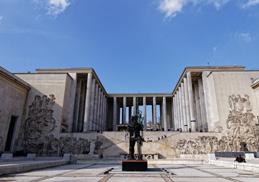
3 minute read
I First Seen At Expo
Innovation
First Seen At Expo
Advertisement
Here are some of the landmarks, inventions, and attractions that were born out of World Expos.
The world’s first Expo took place in London in 1851, after which the concept became repeated globally. In 1928, the Bureau International des Expositions was established to regulate and oversee these megaevents. Throughout their 170-year history, World Expos have debuted life-changing ideas that highlight scientific, technological, economic, and social progress.
1888
Columbus Monument
Barcelona, Spain The 60-metre Columbus Monument (Monument a Colom) was built by Gaietà Buïgas for the 1888 Barcelona Expo in honor of Christopher Columbus and his first voyage to the Americas. The seven-meter tall bronze statue of Columbus points with its index finger towards America. The structure was erected at the lower end of Las Ramblas and still stands today.
1878
Phonograph
Paris, France Thomas Edison introduced his phonograph invention at the 1878 Paris Expo, which was one of his first creations to bring him global recognition. The device was capable of recording and playing back sound, enabling conversations to be recorded. It was composed of a rotating brass cylinder that recorded sound through a needle and tinfoil.
1889
Eiffel Tower
Paris, France
Gustave Eiffel built the Eiffel Tower for the 1889 Paris Expo in just two years, two months, and five days. Considered a feat of French engineering at the time, the iconic Parisian attraction was constructed to celebrate the 100th anniversary of the French Revolution. The 300-meter tower was only intended to last 20 years but stands to this day.
1893
Ferris Wheel
Chicago, U.S. Designed and named after structural engineer George Washington Gale Ferris Jr., the Ferris wheel was unveiled at the 1893 Chicago Expo. The metal wheel stood 264 feet tall and was meant to rival the Eiffel Tower in height. In 1906, a demolition company destroyed the wheel, and its remnants were sold for scrap metal. Inspired by the original Ferris Wheel, a 200 feet Centennial Wheel debuted in 2016 and stands as an iconic part of Chicago’s skyline.
1906
Simplon Tunnel
Milan, Italy The Simplon Tunnel’s opening was the highlight of the 1906 Milan Expo, inaugurated by Italian king Victor Emmanuel III and the Swiss President Ludwig Forrer. The tunnel connects Lausanne in Switzerland and Domodossola in Italy, via Brig. At 19.8kms, the Simplon was the world’s longest railway tunnel for 75 years until 1982, when the Daishimizu Tunnel opened in Japan.
1937
Palais de Chaillot and the Palais de Tokyo
Paris, France Located in the 16th arrondissement of Paris are two iconic buildings constructed for the 1937 Paris Expo—Palais de Chaillot and the Palais de Tokyo. Today, the popular sites house the Musée de l’Homme anthropology museum and the Musée d’Art Moderne de la Ville de Paris, respectively. Following its renovation, Palais de Tokyo became the largest center of contemporary art in Europe in 2012.

1958
Atomium
Brussels, Belgium The Atomium, a giant model of a unit cell of an iron crystal, was created for the 1958 Brussels Expo. The modern-day tourist spot was built by engineerarchitect Andre Waterkeyn. Upon completion, it held a series of records. The Atomium had the fastest lift in Europe in 1958 with capacity to carry 500 people an hour at a speed of 18km/h. Standing at 102 meters high, at the time the attraction ranked as the sixth largest built metal structure globally.
1962
Space Needle
Seattle, U.S. Seattle’s famous Space Needle was a central structure for the 1962 Expo. It took around 400 days to build and cost $4.5 million. The structure’s idea was originally sketched on a napkin in a coffee house by Edward E Carlson, the president of Western International Hotels, during a visit to Stuttgart, Germany in 1959. The Needle was designated an official Seattle landmark in 1999.
1970
IMAX film
Osaka, Japan The 1970 Osaka Expo saw the premiere of the first-ever IMAX film: the Canadian-produced Tiger Child. Its technology was developed by three filmmakers: Graeme Ferguson, Roman Kroitor, and Robert Kerr. The 17-minute short documentary required the audience to move through the viewing space on a large rotating platform, each one viewing the endless film from a different starting point. In 1994, IMAX Corporation went public.










